DCCXV. BACH, J.S. (1685-1750)
In 1723, after taking up his post as Thomaskantor in Leipzig, Bach set this text in 12 movements for Christmas in the key of E-Flat Major.
A decade later, Bach revised the work, dropping the Christmas hymns, altering or expanding some instrumentation, and changing the key to D Major for the trumpets -- their natural key. The probable date for the first performance of this version was July 2, 1733, for the feast day of Visitation (although some scholars believe it wasn't until the following Christmas). That year there had been a period of mourning (February to June) after the death of Augustus the Strong, during which no concerted music was allowed in the churches.
A decade later, Bach revised the work, dropping the Christmas hymns, altering or expanding some instrumentation, and changing the key to D Major for the trumpets -- their natural key. The probable date for the first performance of this version was July 2, 1733, for the feast day of Visitation (although some scholars believe it wasn't until the following Christmas). That year there had been a period of mourning (February to June) after the death of Augustus the Strong, during which no concerted music was allowed in the churches.
The choir is in five voices: SSATB.
The arch symmetry is magical:
- Mvmnts 1/2 & 11/12 in tonic
- Mvmnts 3 & 10 in relative minor
- Mvmnts 5 & 9 in major keys other than D
- Mvmnts 6 & 8 minor key
- Mvmnt 7 tonic
All arias are non-da capo. This is sung by Soprano II, with string accompaniment, continuing the joyful feeling of the opening.
3. Quia respexit humilitatem ancillae suae ecce enim ex hoc beatam me dicent
Luke 1:48
Luke 1:48
Soprano I -- accompanied only by an oboe d'amore and continuo -- sings this magnificent aria. Spitta:
"Scarcely ever has the idea of virgin purity, simplicity, and humble happiness found more perfect expression than in this picture of the Madonna, translated, as it were, into musical language."
4. omnes generationes
The completion of the sentence (all generations) is given to the chorus.
5. Quia fecit mihi magna qui potens est et sanctum nomen ejus
Luke 1:49
Luke 1:49
This short aria for bass is accompanied only by the continuo.
6. Et misericordia ejus a progenie in progenies timentibus eum
Luke 1:50
Luke 1:50
This exquisite duet (alto/tenor) is accompanied by muted strings and flute doubling, in a gentle 12/8 ... the vocalists frequently pause for instrumental sections.
7. Fecit potentiam in brachio suo dispersit superbos mente cordis sui
Luke 1:51
Luke 1:51
He shows Strength! All five voices repeat a melisma on the word potentiam, from tenor, alto, soprano II, bass and soprano I. The conclusion (mente cordis sui) is adagio, illustrated by long chords, with trumpet accents.
8. Deposuit potentes de sede et exaltavit humiles
Luke 1:52Tenor aria accompanied by unisono violins and continuo only.
9. Esurientes implevit bonis et divites dimisit inanes
Luke 1:53Alto aria, accompanied by two flutes and continuo. Stretch out your imagination and you can almost hear a jazz bass player, as the continuo plucks out notes in a steady on-the-beat rhythm! The flutes decorate the alto with compassionate word-painting (he has filled the hungry with good things) ...
Luke 1:54
Here, Bach shows his mastery of composing just the right amount of orchestration -- this is a trio for the two soprani and alto, accompanied only by an oboe and a continuo of only cello.
What is of primary interest here is the oboe part, which is a cantus firmus of Luther's German translation of the Magnificat: Meine Seele erhebt den Herren (My soul exalts the Lord) -- from the original plainchant in the Aeolian mode (today's minor scale). Note how the chant starts on F-Sharp (dominant) and ends on B (tonic):
What is of primary interest here is the oboe part, which is a cantus firmus of Luther's German translation of the Magnificat: Meine Seele erhebt den Herren (My soul exalts the Lord) -- from the original plainchant in the Aeolian mode (today's minor scale). Note how the chant starts on F-Sharp (dominant) and ends on B (tonic):
11. Sicut locutus est ad patres nostros Abraham et semini ejus in saecula
All five voices enter in a fugato from bottom to top. The complex part-writing is typical of Bach's genius in weaving the main motif in and out of a flowing accompaniment that is musical perfection.
12. Gloria Patri, et Filio et Spiritui Sancto. Sicut erat in principio, et nunc, et semper et in saecula saeculorum. Amen.
Doxology
Doxology
The complete ensemble concludes the work with a glorious fugato and then -- changing to a 3/4 meter, the second part of the text (Sicut erat ...) repeats material from the opening movement.

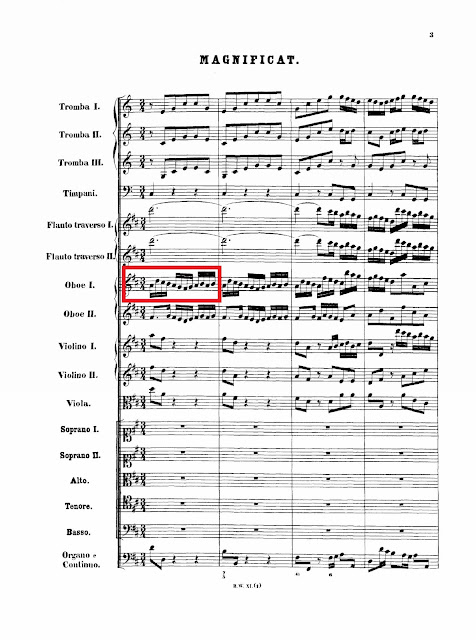
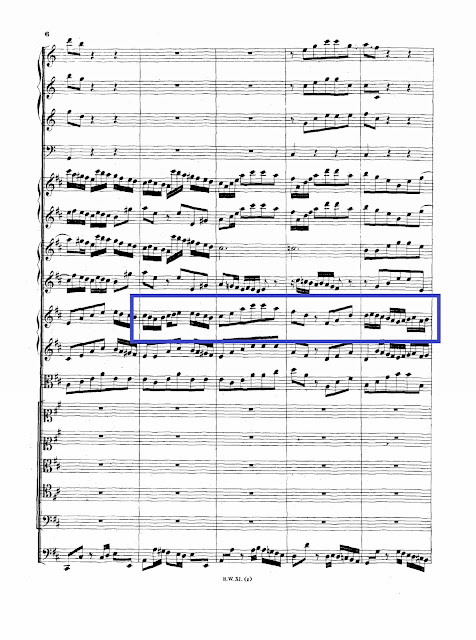
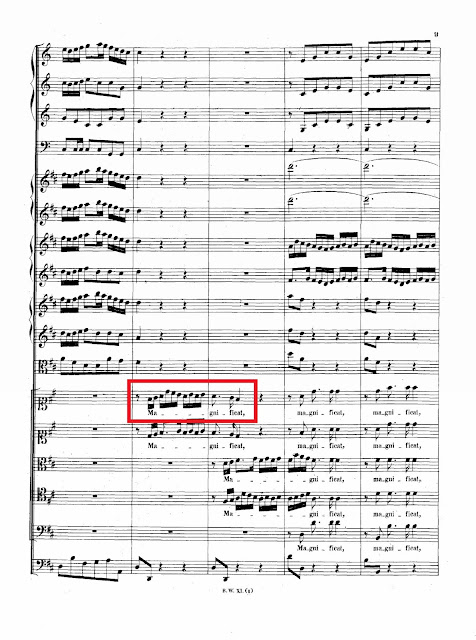
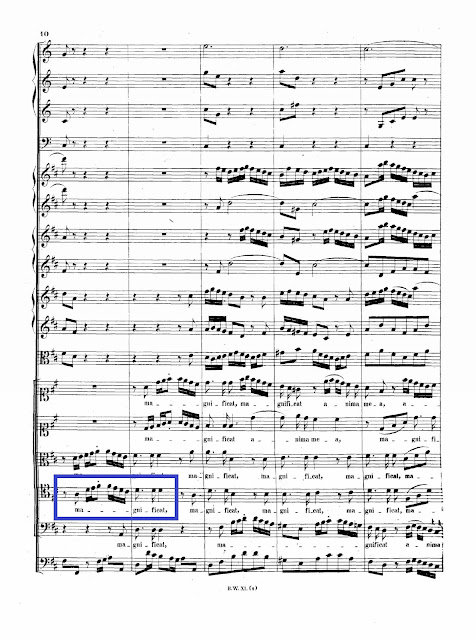

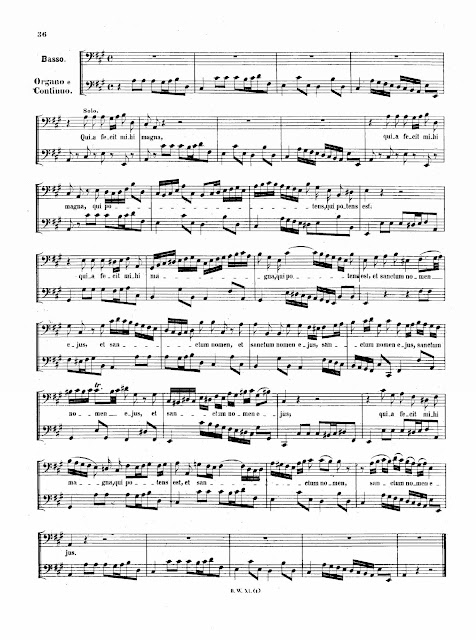

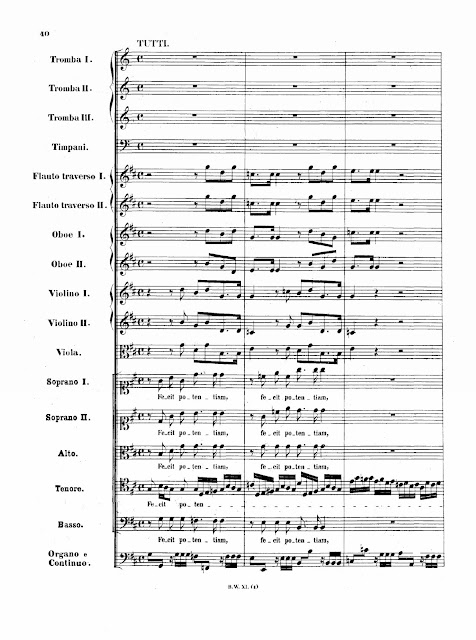








No comments:
Post a Comment